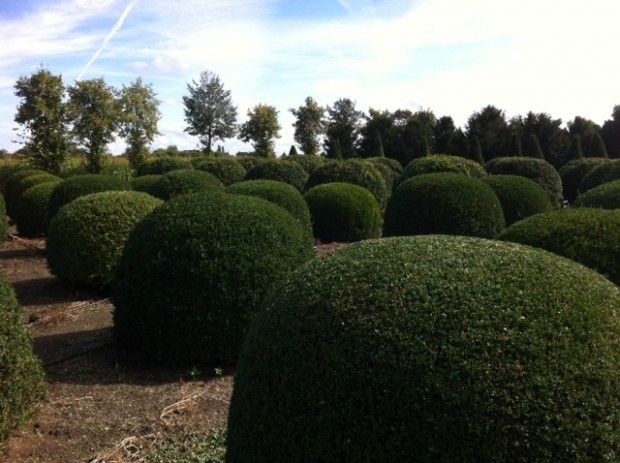
I fancy myself a gardener. That is, my life revolves around making things grow. A landscape design evolves from an idea, to a schematic plan, to a garden that gets planted. Once it is planted, there is a gardener who will see that it grows. A small tree grows up, and creates an atmosphere all its own. A perennial garden takes hold, gains weight, and blooms. Pedestrian ideas die on the vine, and are replaced by those that have lively quality to them. Those who grow-I instantly think about all of the gardeners it has been my pleasure to meet. But those who grow professionally are gardeners of a different sort. What and how they grow is not only an inspiration to gardeners. From start to finish, the life of a landscape is the story of its plants. Outstanding plants are not only irresistible, they are unforgettable.
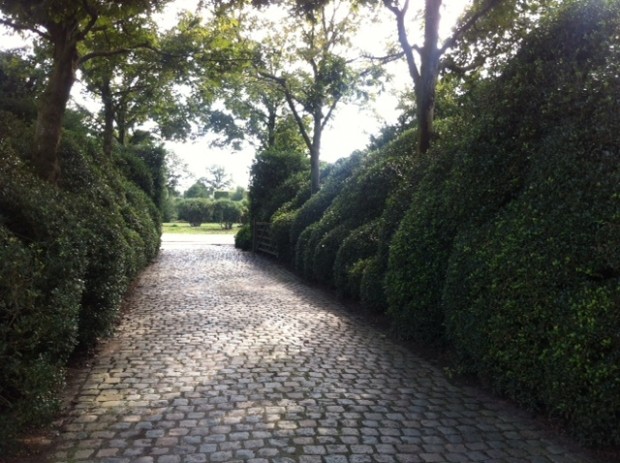
The entrance to this nursery speaks volumes to the point of view of the grower in charge. The paving stones set horizontally in the drive are an invitation, a request to slow down. The cloud-pruned yews spilling over the edges of the drive-stunning.
This nursery is devoted growing a select group of plants. Woody plant material painstakingly pruned into shapes. Not every plant responds to shearing. This gardener has a special interest in those plants that handle this kind of pruning with aplomb.
These plants are beautifully grown. They are spaced such that every one gets its fair share of sun and air. Each boxed tree matches its neighbor-the branching is the same distance from the ground from the first to the last. Each box is pruned to the same size, tree after tree. The boxwood cubes are no different. The size and shape is utterly uniform. Alternately the trees and the shrubs is not only exquisite to see, it makes the most efficient use of the space. 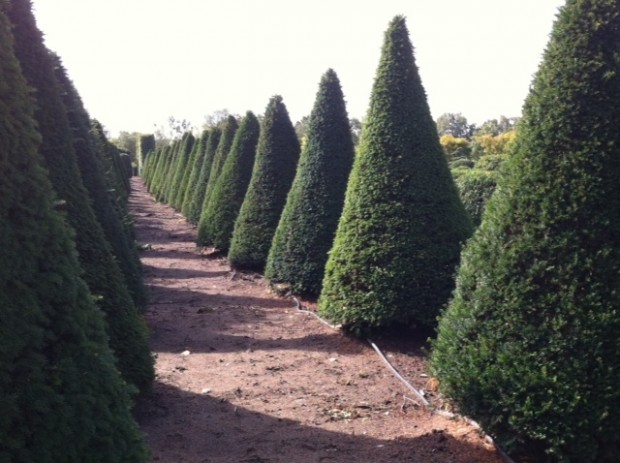
Growing yews like this takes many years, enormous skill, and incredible patience. Unlike a nursery where the stock turns over quickly, this grower has invested lots of time and a lot of land to the cultivation of a few great plants.
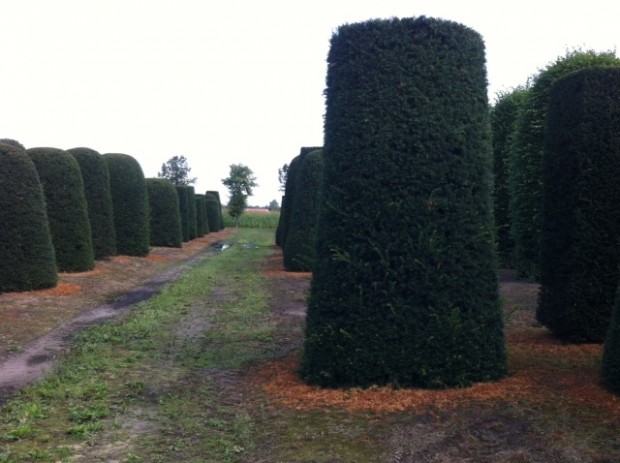
Even in climates with long growing seasons, plants of this stature take years to grow. The pruning is an ongoing process, a little at a time. The yew clippings on the ground-no longer than 6 inches. Even the clippings are uniform in shape and length.
Some of the hedging plants are grown in sections. I am sure when the section is dug, each individual plant is labelled as to its position in the row. The overall shape made by the group-striking.
A collection of individual specimen evergreens grown in boxes makes the transportation to a new home somewhat easier. Just to speculate about what one might do with one, or two, or 4 plants of this caliber-a pleasure.
These carpinus are being trained into arched shapes. The fact that they have foliage all the way to the ground suggests that the training began when they were very small plants. Trees in ground like this are regularly root pruned, which makes the task of transplanting easier. Pruning the roots means a dense fibrous mass of roots will help keep the root ball intact when a plant is dug. Though it may seen counter intuitive, moving a tree the first time is the most harrowing move of all. The roots that get cut eventually sprout multiple roots at the cut. Every successive move is easier, as the development of a dense root system aids in the transplant process.
The ability of a plant to make densely fibrous and compact rootballs plays a large part in whether it is commercially grown. Certain types of junipers are difficult to transplant, as their rootballs have a tendency to collapse. Even container grown roses need to be transplanted with great care, for the same reason. These topiaries and espaliers are grown from just a few species-yew, boxwood, carpinus, and beech.
I think all of these plants are beautifully sculptural-I would have any of them. But whether or not formally pruned trees appeal to you or not, the care, committment and vision with which they are grown is obvious. Yes, these trees are expensive-just any other gorgeous one of a kind sculpture. Where do you find trees like this? Anywhere you find a grower with a big love for growing. No small part of their beauty is how they suggest that any gardener with a small plant and an equally big love for growing could create one of their own.

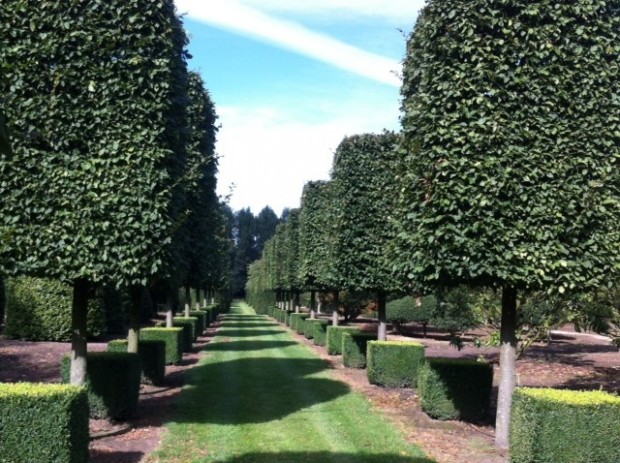
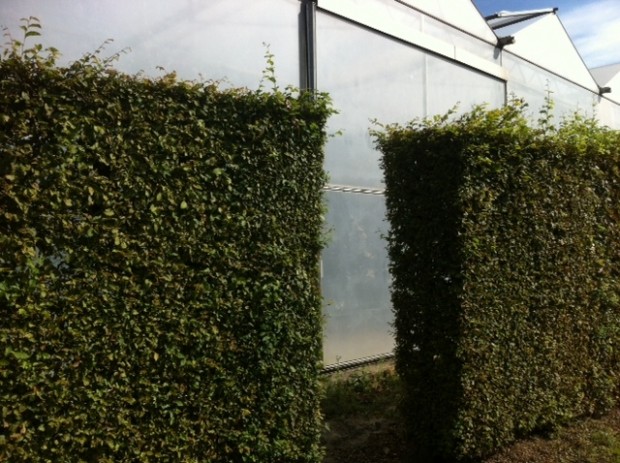
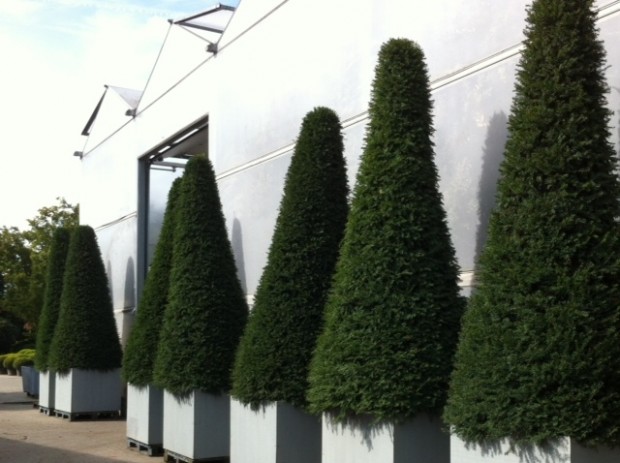
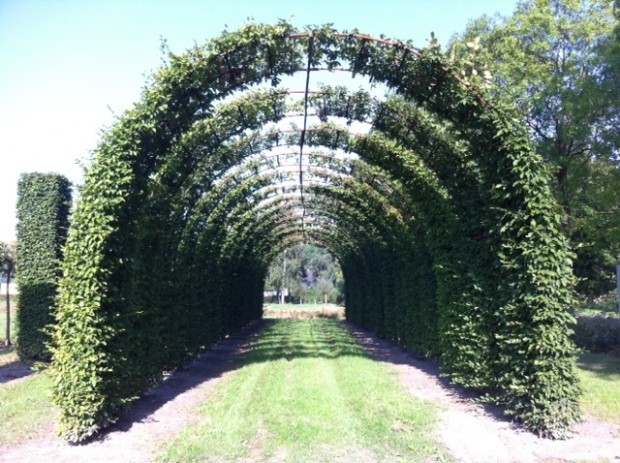
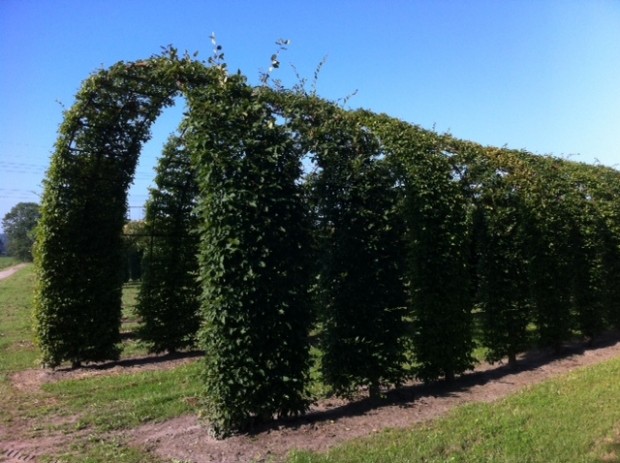
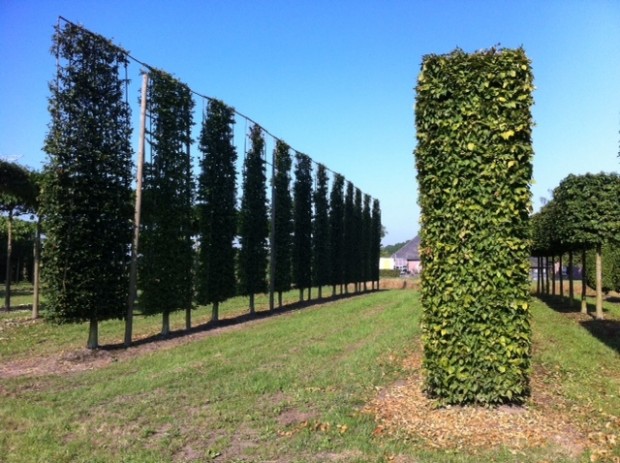
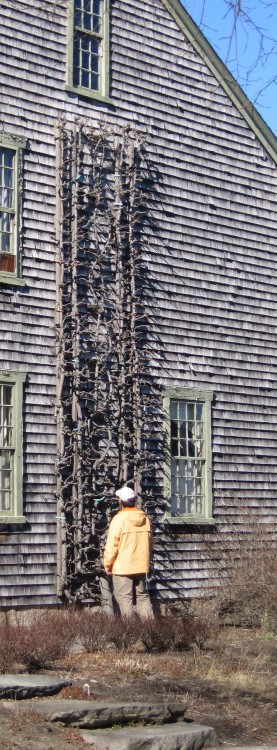 Would not the silhouette of this tree, trained and grown parallel to a wall, get your attention? Even out of leaf, it is striking. You are looking at an espalier- a tree trained to grow in only two dimensions. In the late 1600’s, Fr. Legendre, a monk living in Hanonville France was in charge of his monastery’s garden. His fruit trees were bedevilled by late frosts that killed the fruiting buds. Noticing that the fruit trees planted closest to the monastery walls sustained the least damage, he began planting his fruit trees as close to the walls as possible. As wall space was limited, he began shearing his trees, so as to provide room for all the varieties he wanted to grow. Amazingly, the drastically sheared trees produced heavier yields than unpruned trees in the field. His book, Palmette Legendre, was published shortly before his death in 1684. This book is the earliest known text regarding the science of growing espaliers. These trees, pruned flat, spare, and parallel to a wall, had fewer cultural problems, took up little space, and were beautiful to boot.
Would not the silhouette of this tree, trained and grown parallel to a wall, get your attention? Even out of leaf, it is striking. You are looking at an espalier- a tree trained to grow in only two dimensions. In the late 1600’s, Fr. Legendre, a monk living in Hanonville France was in charge of his monastery’s garden. His fruit trees were bedevilled by late frosts that killed the fruiting buds. Noticing that the fruit trees planted closest to the monastery walls sustained the least damage, he began planting his fruit trees as close to the walls as possible. As wall space was limited, he began shearing his trees, so as to provide room for all the varieties he wanted to grow. Amazingly, the drastically sheared trees produced heavier yields than unpruned trees in the field. His book, Palmette Legendre, was published shortly before his death in 1684. This book is the earliest known text regarding the science of growing espaliers. These trees, pruned flat, spare, and parallel to a wall, had fewer cultural problems, took up little space, and were beautiful to boot.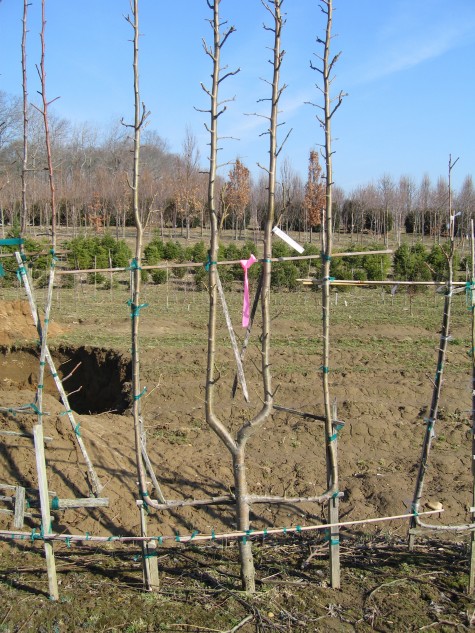 Espaliered fruit trees look like no naturally growing tree . Though no tree expert would advise this kind of planting, pruning and shaping, Father Legendre’s ideas practices enabled ample fruit for everyone living at his monastery. Sometimes the hand of man comes to good end in the environment. This very early spring picture shows an espaliered tree, grown in the candelabra shape. It would be beautiful, grown on a blank wall-never mind the fruit. Training trees to grow in two dimensions became a gardening art form-even for those who had no need to feed many from a very small plot of land.
Espaliered fruit trees look like no naturally growing tree . Though no tree expert would advise this kind of planting, pruning and shaping, Father Legendre’s ideas practices enabled ample fruit for everyone living at his monastery. Sometimes the hand of man comes to good end in the environment. This very early spring picture shows an espaliered tree, grown in the candelabra shape. It would be beautiful, grown on a blank wall-never mind the fruit. Training trees to grow in two dimensions became a gardening art form-even for those who had no need to feed many from a very small plot of land. 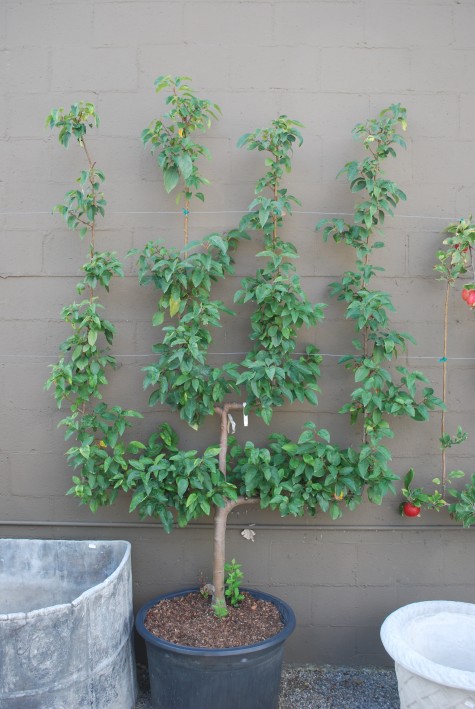 I make a special effort to offer exceptional espaliered trees to my clients. My grower of choice is of French descent, and his espaliers take my breath away. I drive a day’s length to see and review his espaliers. He grows in the traditional way, and only has a few trees to offer for sale every year. He sells no trees that are not at least seven years old; his big trees are much older. He pots his trees, and then sinks the pots in the ground. Note that the trunk of this tree is positioned to the back of its pots-his trees are easy to plant close to a wall.
I make a special effort to offer exceptional espaliered trees to my clients. My grower of choice is of French descent, and his espaliers take my breath away. I drive a day’s length to see and review his espaliers. He grows in the traditional way, and only has a few trees to offer for sale every year. He sells no trees that are not at least seven years old; his big trees are much older. He pots his trees, and then sinks the pots in the ground. Note that the trunk of this tree is positioned to the back of its pots-his trees are easy to plant close to a wall. 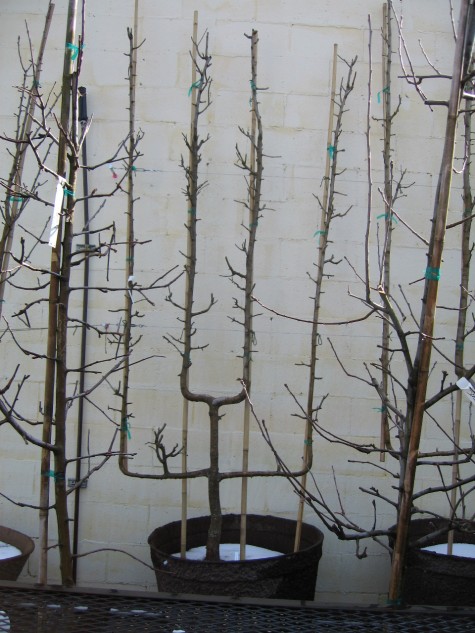 Their winter appearance is architectural. The American landscape is fundamentally based on big spaces; we have eight lane highways and driveways 22 feet wide. This makes this particular dose of French editing all the more refreshing. People who come to my store are invariably interested in their history and forms.
Their winter appearance is architectural. The American landscape is fundamentally based on big spaces; we have eight lane highways and driveways 22 feet wide. This makes this particular dose of French editing all the more refreshing. People who come to my store are invariably interested in their history and forms. My grower trains some of his espaliers in a form not existing in the classical literature. This framed heart is entirely his invention; how I love this. It has a distinctly American feeling; he has taken his classical training, and gone beyond.
My grower trains some of his espaliers in a form not existing in the classical literature. This framed heart is entirely his invention; how I love this. It has a distinctly American feeling; he has taken his classical training, and gone beyond. 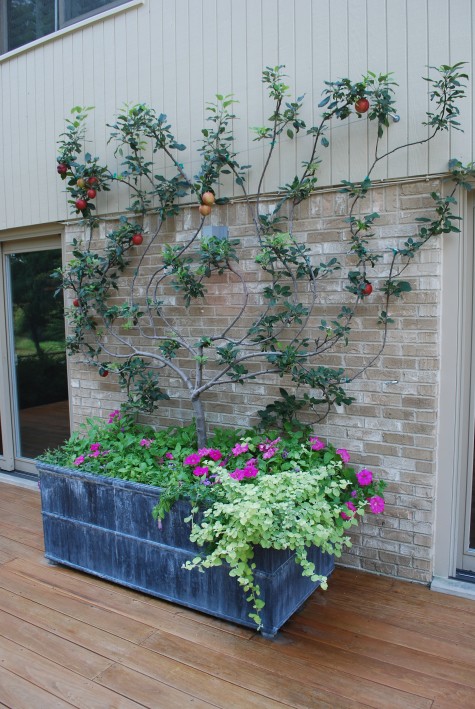 This informal heart espalier enchanted one of my clients. I call it the wild at heart espalier. As she had no room in the ground, we built her a box for her deck, insulated to slow the freeze, and delay the spring thaw; this apple tree is thriving. We heap up the compost after the ground freezes, and we uncover it in the spring; so far, so good.
This informal heart espalier enchanted one of my clients. I call it the wild at heart espalier. As she had no room in the ground, we built her a box for her deck, insulated to slow the freeze, and delay the spring thaw; this apple tree is thriving. We heap up the compost after the ground freezes, and we uncover it in the spring; so far, so good.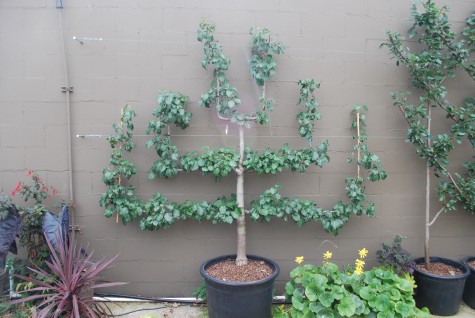 Not all espaliers are fruit trees. The art of training espaliered trees has extended to many trees tolerant of this treatment. This Bradford pear makes a big statement as an espalier. Any lonely wall would be all the happier for this tree planted on it.
Not all espaliers are fruit trees. The art of training espaliered trees has extended to many trees tolerant of this treatment. This Bradford pear makes a big statement as an espalier. Any lonely wall would be all the happier for this tree planted on it.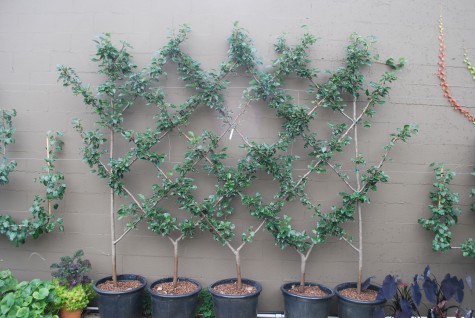 This series of trees is known as a Belgian Fence. You can see that individual trees were topped low to the ground as whips, encouraging branching in both directions. The branches of these trees are trained in a diamond pattern; what a beautiful living ornament for a long wall, or a free standing fence.
This series of trees is known as a Belgian Fence. You can see that individual trees were topped low to the ground as whips, encouraging branching in both directions. The branches of these trees are trained in a diamond pattern; what a beautiful living ornament for a long wall, or a free standing fence.